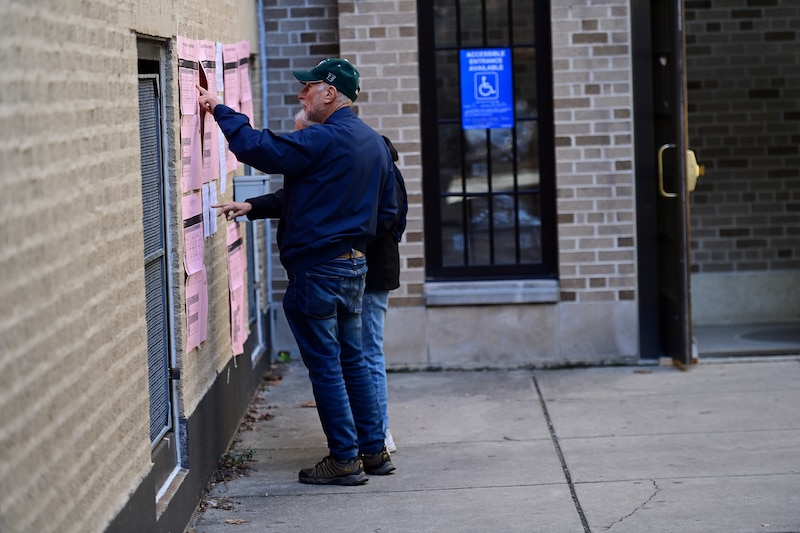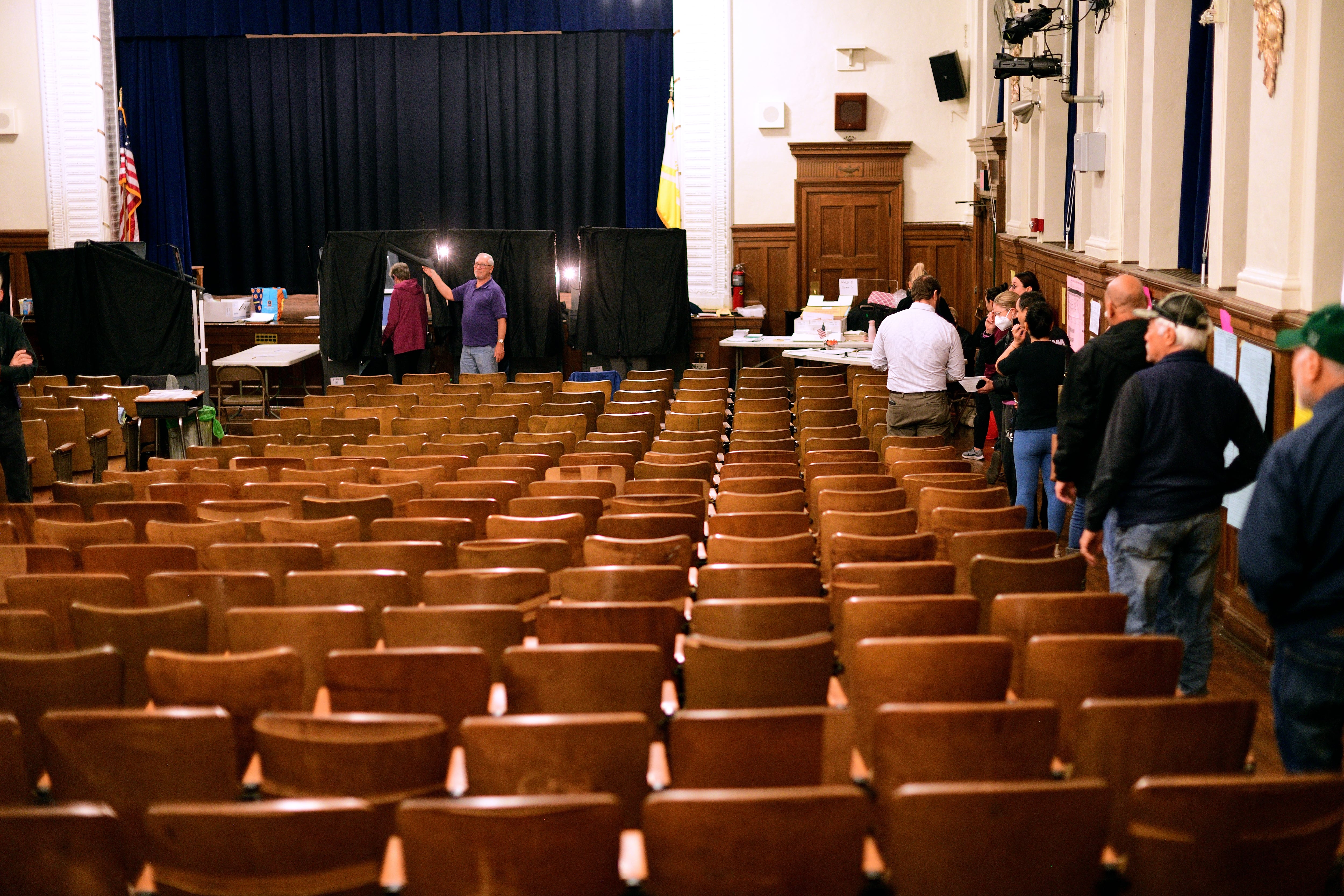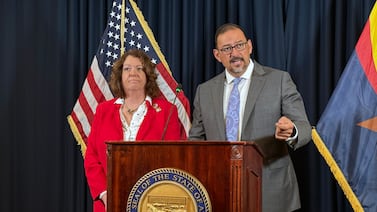Votebeat is a nonprofit news organization reporting on voting access and election administration across the U.S. Sign up for our free newsletters here.
Suzanne Erb, a blind voter in Center City, never takes for granted that she’ll be able to cast a ballot on Election Day.
She’s had to wait long periods to be able to use an accessible machine and circled her polling place at Arch Street Presbyterian Church to find the entrance.
Despite decades-old laws mandating equal access to the ballot box for voters with disabilities, “I still don’t feel like I have the right to vote independently and privately all the time, even though I have it on paper,” said Erb, who is 67.
Philadelphia will likely choose its next mayor and fill other key roles in city government in the May 16 primary elections. Despite making strides in election accessibility, the city still falls short of providing the equal voting experience required by law, according to interviews with several voters with disabilities and disability rights experts. For example, they say equipment needed to make polling locations wheelchair accessible is often missing on Election Day, and voters who need other accommodations are sometimes treated as an afterthought.
“There’s a lot of … ‘Throw a ramp on it. Oh, it’s accessible,’” said Lauren Alden, interim director of Independent Living Services at Liberty Resources, a nonprofit that provides advocacy and support for people with disabilities in the Philadelphia region.
The Americans with Disabilities Act requires local governments to ensure “a full and equal opportunity to vote” for people with disabilities. This applies to all parts of the voting process, from registration to early voting to voting in person on Election Day.
Subsequent laws like the Help America Vote Act of 2002 require at least one accessible polling machine per location and that voters with disabilities have the same opportunity for access and participation, including privacy and independence, that other voters get. That means voters with disabilities shouldn’t have to rely on someone else to help them mark their ballot, which compromises the secrecy of their vote.
The Philadelphia City Commissioners Office, which administers elections, denies that there are issues with accessibility.
“The city has worked to ensure that all of our polling places are wheelchair accessible,” said deputy commissioner Nick Custodio, noting that new voting machines “[allow] voters with disabilities to cast their ballot on the same device as every other Philadelphia voter.”
But advocates say these protections can exist more as an ideal than a reality.
“We get complaints every year” about voting access, said Vicki Landers, founder and executive director of Disability Pride PA.
A history of excluding voters with disabilities
In 2019, Pennsylvania adopted no-excuse vote-by-mail, a boon to anyone who does not want to go to their polling place on Election Day. That change also expanded access for some voters with disabilities, who use mail-in ballots at a higher rate than voters without disabilities, according to a study of 2020 voter turnout.
But, mail ballots present their own barriers, and the OmniBallot, a program for voters with visual impairments to vote electronically, has had a flawed rollout, according to a recent report by Disability Rights Pennsylvania. In-person voting remains a preference for many voters with disabilities who do not trust the mail or who may not decide who to vote for until Election Day.
However, nearly one in five American voters with disabilities report difficulties voting in person, around twice the rate of voters without disabilities, according to the U.S. Election Assistance Commission. Philadelphia, where some neighborhoods have rates of disability as high as 42%, has a specific history of excluding such voters.
In 2007, several Philadelphia residents initiated a class action lawsuit against city officials, alleging that around a quarter of all polling locations were out of reach to voters who could not walk up and down stairs. In a subsequent 2009 settlement, the U.S. Department of Justice required Philadelphia to make changes to allow people with mobility impairments to vote in-person.
The DOJ ordered the city to hire an independent expert to evaluate polling locations and to follow recommendations that experts made on how to temporarily modify them for accessibility on Election Day. Such modifications might include using mats to smooth the grade changes in a floor, installing temporary ramps, removing the posts in-between double doors, or blocking off an accessible parking space with cones. If these modifications proved impossible, for example, if a hallway is too narrow to permit a wheelchair to pass through and there is no alternate accessible entrance, evaluators would suggest a more accessible location nearby.
However, a decade later in 2019, the Philadelphia Inquirer reported that the city still had 22 polling locations considered “not handicapped accessible,” meaning the sites did not meet ADA accessibility requirements and no suitable relocation site had been identified.
That year, the city adopted new voting machines that had to be wheeled into polling locations, forcing the city to finally modify or move those locations.
Falling short of equal voting access
While there are no longer any locations considered fully inaccessible under ADA standards, only about one-third of the city’s 1,703 precincts vote in buildings considered “fully accessible,” according to information posted by the Philadelphia City Commissioners in April. An even smaller number, 142, also have a handicapped accessible parking space, according to Custodio.
Another 59 precincts vote in buildings in which one or two of the ADA criteria are not met “by a slight margin, but it is acceptable because there are no better options” for those polling places, according to a rubric shared by Custodio.

That means the majority of polling locations require a portable ramp or other temporary modifications to the space to meet wheelchair accessibility requirements, or signage to direct voters to an alternate accessible entrance, like a back door that leads to the building’s elevator.
“What we found is, a lot of times, the ramp’s not out,” said Alden, of Liberty Resources.
If a voter is not comfortable speaking up and asking for the ramp to be put out and leaves, “that could prevent someone from voting just by not being out all the time,” said Alden. She said many complaints about ramps in the last election cycle came from locations in Northeast Philadelphia.
The situation can also present a conundrum: How is a voter supposed to request a ramp if they can’t even get inside a building to talk to a poll worker?
The City Commissioner’s Office is aware of missing ramps and has “worked to address these concerns and believe that the situation has improved recently,” said Custodio. He noted that portable ramps are now stored on-site, and poll workers are reminded to put them out before 7 a.m. on Election Day
Once inside, barriers can persist. The width of hallways, or obstructions like chairs and bookcases, can make even a polling place with a ramp inaccessible, said attorney Jennifer Garman, director of government affairs with Disability Rights Pennsylvania. That group runs a voter hotline on Election Day, and she confirmed ongoing complaints from voters.
“It’s not only about getting into the polling place, it’s about being able to navigate through it as well,” she said.
Voters with a disability or who are over 65 whose polling places are not considered fully accessible under the law are entitled to vote by alternative ballot, an option very similar to a mail ballot and which generally must be requested at least seven days before an election. Landers noted that this falls short of the standard of equal access.
“Why should we have to do that?,” she said.
Voting machines improved, but not perfect
Beyond modifications for wheelchair users, some Philadelphia voters with disabilities complained that the machines themselves, though better than older voting technology, are not fully accessible.
Before the 2020 election, Philadelphia replaced older machines with the ExpressVote XL. These have many accessibility features, such as the ability to raise or lower the height of the screen, audio playback, and a keypad with Braille lettering, and the ability to connect to assistive technology like a rocker switch and Sip-and-Puff devices.
But according to the city of Philadelphia’s video guide to using the machine, poll workers must initiate many of these features and be available to place the machine in assistive mode. Lack of training or awareness among poll workers, already in short supply, can thus be another barrier to voting.
“The last couple times they didn’t really have it set up. There is supposed to be something that talks to us … but they didn’t have that available,” said Yvonne Hughes, a 68-year-old advocate for the visually impaired. Hughes has a hereditary eye disease that causes vision loss and sensitivity to light.
She said to avoid getting turned away, she generally chooses not to vote privately.
“I bring my daughter every time, just so I’m not running into a problem,” said Hughes.
City officials say all poll workers receive training on how to set up the ADA-compliant attachments, which come pre-plugged into the back of the voting machines. In response to Hughes’ specific concerns, Custodio said his office could contact poll workers at her voting location to discuss the issue.
Garman, the disability rights lawyer, as well as others, noted that equity can’t be something that’s fixed once and for all. With turnover in poll workers and election officials, gains in accessibility can be lost again.
“These issues very much continue to be ongoing,” she said. “They can be fixed for one election and there could be an issue again in the future.”

This article is a part of Every Voice, Every Vote, a collaborative project managed by The Lenfest Institute for Journalism. Lead support is provided by the William Penn Foundation with additional funding from The Lenfest Institute, Peter and Judy Leone, the John S. and James L. Knight Foundation, Harriet and Larry Weiss, and the Wyncote Foundation, among others. To learn more about the project and view a full list of supporters, visit everyvoice-everyvote.org. Editorial content is created independently of the project’s donors.
Votebeat freelancer Laura Benshoff is a reporter and audio producer in Philadelphia. She has covered local issues for WHYY, NPR, and the Center for Investigative Reporting




